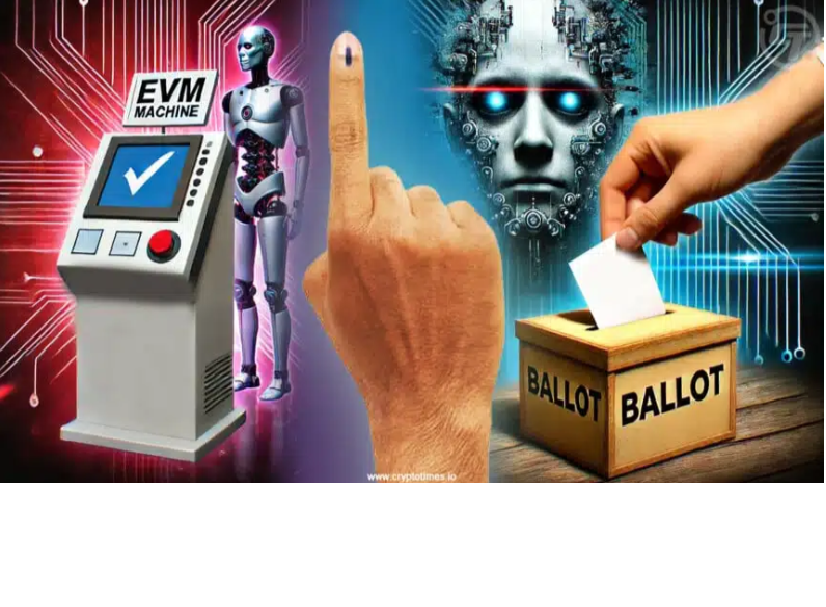
“We should eliminate electronic voting machines (EVMs). The risk of being hacked by humans or AI, while small, is still too high (sic)”.
– A tweet by tech mogul Elon Musk on the vulnerability of electronic voting machines (EVMs) has created a political slugfest in democracies from the West to the East.
What is the EVM controversy in India all about?
History of EVMs in India
EVMs have been in use in Indian elections for the past 40 years. Prior to EVMs, citizens voted on ballot paper, a practice that was ultimately discarded, due to rising cases of loot of ballot boxes by anti-social elements to influence elections.
How does EVM function?
According to the Election Commission of India, EVMs consist of three units- Ballot Unit, Control Unit and Voter Verified Paper Audit Trail (VVPAT). While the Ballot Unit is used by voter to cast their vote, the control unit is with the presiding officer to verify the voting and the VVPAT system allows the voter to verify the vote they casted. The ECI uses EVM Management System (EMS) to keep an audit of every voting machine used in the electoral process-right from manufacturing hub to storage to presiding officer responsible for conducting elections. The process is centralized and under the supervision of the chief election commissioner (CEC) of the ECI. For more information on the general elections 2024 of India, readers can refer to the official website of ECI.
Why is the Indian opposition unhappy with the ECI over EVMs?
The opposition parties in India have questioned the vulnerability of using EVMs for the electoral process and alleged discrepancies during the counting process on many occasions. There are two basic demands by the opposition leaders related to EVM- first is parallel counting of VVPAT receipts with votes and second is alleged vulnerability of the digital infrastructure of EVMs.
As explained earlier, the VVPAT system was introduced as part of the EVM in 2013, and under this process, the voter can view the receipt of the vote he cast, for a duration of seven seconds, before the receipt goes to a separate box. The opposition leaders have been demanding a simultaneous counting of VVPAT receipts along with votes to tally the final score.
The opposition has also questioned whether the EVMs are technically fool-proof enough to sustain against cyber attacks by state or non-state actors.
MP Rahul Gandhi, a key opposition leader, took to Twitter and replied to Elon Musk’s tweet, calling EVMs as a “black box that no one is allowed to scrutinize.”
How has the ECI replied to the accusations?
The ECI has categorically rubbished the allegations of the opposition parties over EVMs vulnerability against cyber attacks. As widely reported in the local media, the ECI had invited several opposition parties to give them a “demo-proof” of whether EVMs can indeed be rigged.
Additionally, the ECI regularly conducts awareness campaigns online and offline to clear doubts on the veracity of EVMs and their electoral process. It maintains that it is impossible to hack the EVMs and manipulate elections.
The Big AI question
Earlier in June this year, OpenAI- the makers of ChatGPT- released a report claiming that it thwarted attempts to manipulate the ongoing Indian elections by misuse of AI. OpenAI claimed that an Israel based company was hired to manipulate ChatGPT and post negative comments on social media posts of the ruling party in India.
Three months earlier, Microsoft had released a report claiming that AI cyber attacks will be conducted during the Indian and US elections this year.
Increasing reports of use of AI to spread misinformation, propaganda and manipulate voters have also been witnessed in Pakistan and other South Asian democracies.
The ECI has claimed-post the elections in India-that it has thwarted attempts of using deepfake and other AI related propaganda content on social media.
Murphy’s Law?
There is a popular saying in English, “just because something has not happened in the past, it doesn’t mean it won’t in future.” The saying echoes the principles of Murphy’s law that states “anything that can go wrong, will go wrong.”
In its essence, the tweet by Musk stating, “the risk of being hacked by humans or AI, while small, is still too high” plays on similar sentiment and opens up debate whether we should allow major events like the electoral process to be susceptible to AI attacks.
When Musk had posted this tweet, a former Indian minister of state (MoS) for Information Technology, Rajeev Chandrashekhar, tried to counter his point by claiming ,”..Indian EVMs are custom designed, secure and isolated from any network or media-no connectivity, no bluetooth, wifi, internet-there is no way in..(sic).”
Musk replied to Chandrashekhar claiming, “Anything can be hacked (sic).”
It is thus clear that Musk’s assertions are not based on whether there are any chinks in the armour right now, but whether a chink can be carved out or not.
Conclusion
As the world is increasingly adopting AI and its applications into our day to day lives, there is also a growing distrust of this technology and doubts are increasing whether humans would be able to thwart the possible weaponization of AI. Even in the United States, over 70% of total voters have voted with hand marked paper ballots while the remaining 30% voted with machines that physically mark paper ballots, as per a report by Reuters. As democracies are using AI and other web3 concepts in their day-to-day governance, it remains to be seen whether they will take a hard stance towards possible rigging attempts in their elections- by humans or AI.
Retrieved from: https://www.cryptotimes.io/2024/06/17/ai-evms-and-all-that-democracy-how-musk-fanned-an-election-controversy-in-india/



